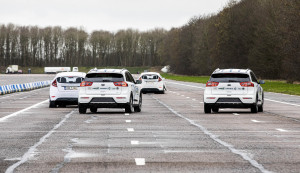CAVs and ADAS: current and future
Right now, we are stepping into a world of connected and automated vehicles (CAVs). Here we explore what those concepts really mean today, how they will work together in future, and what that means for companies developing and testing the technology.
Connectivity in vehicles takes two broad forms today: firstly, an internet connection allows over-the-air software updates, remote assistance, traffic information and fleet management. Secondly, peer-to-peer radio messaging allows fast local communications from other vehicles or roadside units such as warning of hazards ahead, hard braking alerts, or speed advisories to cruise through green lights. These latter features are still rare in production vehicles, but their inclusion in the Euro NCAP safety roadmap can only hasten development and release.
Meanwhile, the push for automated driving rests on compelling pillars: safety, economy, efficiency, and inclusivity. Relieving humans of the driving task promises reductions in accidents; driverless operation offers reduced costs and more use out of fewer vehicles; and affordable mobility becomes available to those who cannot drive. Fully driverless transport is only just underway worldwide with a few trial robotaxi fleets, but automated passenger shuttles are poised for deployment in the EU.
Advanced driver assistance systems (ADAS) bring many safety benefits today based on the perception and actuation systems fully automated vehicles will need tomorrow. For example, Automatic Emergency Braking (AEB) and Emergency Lane Keeping systems (ELKS) are becoming mandatory equipment in the EU; both depend on cars interpreting the world they “see” to identify vehicles, pedestrians and lane boundaries, and the ability to automatically brake and steer.
IDIADA’s CAVRide project showcases both advanced automated driving and ADAS features, developed in-house. It navigates the roads at our Spain headquarters autonomously to provide a shuttle service, but also has proven automated braking and steering capabilities to avoid collisions, which have been tested on our specialised ADAS track.
Looking forwards, connectivity and automation will come together in CAVs. High-speed internet can continually update high-definition maps in vehicle, keeping their ability to locate themselves and plan their movements up to date. In the other direction, vehicles can upload unusual snippets of video and other sensor data to the maker’s servers to improve the algorithms later downloaded again over the air. Shared mobility requires that vehicles are online for booking, tracking and passenger access. And finally, network accessibility allows remote operation by a human operator when necessary.
Short-range communications allow real-time interactions between different vehicles and road infrastructure. For example, junctions with camera units can broadcast details of the vehicles and pedestrians they see, allowing any nearby receiving vehicles a knowledge of traffic they cannot necessarily detect for themselves, increasing their ability to safely avoid collisions with unexpected participants.
IDIADA is a key member of the ENSEMBLE consortium, in which vehicle-to-vehicle (V2V) messages are used to set up an on-road train or “platoon” of trucks from different OEMs, with the aim of reducing fuel consumption, avoiding sudden braking or even accidents, and ultimately eliminating the need for human attention in the following vehicles.
A very different V2V control concept was successfully demonstrated in the MuCCA project, led by IDIADA in the UK. Here fully automated cars were programmed to share their intentions over the radio link, allowing them to pre-emptively cooperate with each other to avoid highway obstacles. Demonstrating this cooperative collision avoidance in real cars was a world first.

Testing the technology
Testing these technologies is vastly more challenging than the validation of traditional automotive features. With an infinity of situations that could emerge on the real roads, developers must test very widely to ensure proper confidence in the safety of these systems.
A large part of the development and testing of CAV and ADAS technology makes use of simulation environments, where the vehicle control systems can be challenged with a huge range of traffic scenarios. However, safe and appropriately equipped physical facilities are also essential. IDIADA has both completed and ongoing work to provide the specialised real proving ground facilities needed, backed up by supporting “digital twins” for simulation testing.
At our Spain HQ, IDIADA already has dedicated test areas for CAV/ADAS functions, but we are additionally building our “CAV2” environment offering a highway/interurban loop and areas that can be defined as urban junctions. Using robot-controlled “soft target” vehicles, pedestrians and cyclists, we can set up accurately controlled physical tests of situations that could never be safely performed on public roads or with unprotected participants. We also have V2X roadside units and a private 5G network.
Our China proving ground similarly offers multi-purpose platform areas for ADAS testing, alongside tracks for testing handling, durability, braking and high-speed driving.
In the UK, IDIADA’s new CAVWAY proving ground will be opening in Q4 2022. It offers the key features of a motorway-representative track including junctions, and both private 4G/5G cellular and short-range controllable connectivity. Within the highway loop are supplementary areas for ADAS testing and smaller junction layouts.
CAVWAY has the key capability of being able to coordinate vehicle movements, network activity and digital traffic signals. For example, the cellular system can be shut down or degraded on demand just as a vehicle is attempting to merge between trucks in a platoon; emergency vehicle V2V messages sent from roadside units can spoof the approach of blue-light services; and digital signs can be timed to change in response to vehicle position. These abilities will allow reproducible “edge case” tests of awkward situations that could not be orchestrated on public roads.
All of these proving grounds offer workshops where clients can maintain and store vehicles, and transfer data through high-speed internet.
IDIADA offers not just the facilities, but the skilled engineers needed to support development and test activities, and the accreditation to make formal assessments for Euro NCAP and homologation. Together, we are your complete partners for CAV and ADAS developments.